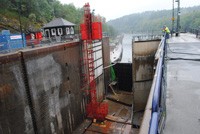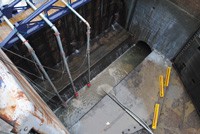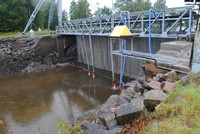Swedish Maritime Administration
Trollhattan, Sweden

Trollhatte canal emptied
When it was decided that new doors needed fitt ing on the four locks at Trollhattan on the Trollhattan Canal in central Sweden, the Swedish Maritime Administration turned to Sjuntorp Industrisupport AB for dewatering help. The requirement, to pump 37 million litres of water out of the locks and keep them dry throughout the entire process, was handled by 26 Grindex pumps. After 25 days the project was considered a success and the locks were reopened.
Essential renovation of an important piece of history
When the Trollhattan Canal was opened in 1800, it made the waterways of western Sweden, between the North Sea and Lake Vänern, accessible by sailing ship. Since then the 82 kilometer long stretch of the River Göta, which rises 44m in total, has gone through a number of major upgrades. The six locks, for example, all have double floors and electrically and mechanically operated doors and gates. Inspections by the Swedish Maritime Administration however, revealed that the gates at the four Trollhattan locks could become a potential hazard. Therefore, on August 25th 2011, the canal was closed at Trollhattan for essential repairs, including renovation of the locks, changing/upgrading of the lock pumps and installation of the new doors.

Around the clock pumping
Each lock, which can house ships up to 4000 metric tonnes, 89m in length, 13m wide and 5.4m deep, typically holds approximately 9500m3 of water, the equivalent of 9 seconds of water flow in the River Göta. With four locks to empty, powerful and reliable pumps that could operate around the clock were required. The Swedish Maritime Administration, which is responsible for the locks, contacted Sjuntorps Industri Support, as they have successfully handled the dewatering process in the past. With over 300 contractors on site and tight deadlines to meet, it was imperative that every stage of the operation went according to schedule. This of course meant ensuring the locks were kept dry at all times.
Big pumps for a big job

Armed with information from past projects at Trollhattan, staff from Grindex’s technical department assisted Sjuntorps Industri Support AB with the sizing of the pumps. With 37 million litres of water to be drained before work could get started, 3 slurry, 22 drainage and 1 sludge pump (including stand-by pumps) were recommended, the largest of which can handle 12 m3 water/min.
Work began emptying the locks on Friday night, and by Sunday at around midday the job was completed and work could begin on the renovations. “The drainage pumps were used for the first stage and the sludge and slurry pumps were used to remove the water under the upper floor of the locks,” says Grindex sales engineer, Rolf Mejbert. “This water is quite different to the majority of the water as it’s much denser. Mud, sediment and even quite a lot of fish can be found down there. Fortunately we were able to pump the fish out without harming them,” he concludes.
Trusted partner

The Grindex pumps remained on site throughout the project removing rainwater and water leaking through the canal doors. According to Hakan Ohrling, of Sjuntorps industri Support AB, “This is the third time that we have assisted The Swedish Maritime Administration with this operation. On a project of this scale, with so much at stake and so many contractors relying on you, everybody needs to know that your pumps can handle the task at hand, keeping the locks dry around the clock. Therefore we had a service agreement to ensure that the pumps were operational throughout the process.”
After 25 days the project was deemed a success and the canal was re-opened to shipping. As for the Grindex pumps, they were given a standard service and put back into storage awaiting the next rental project.
